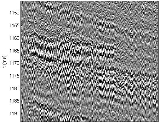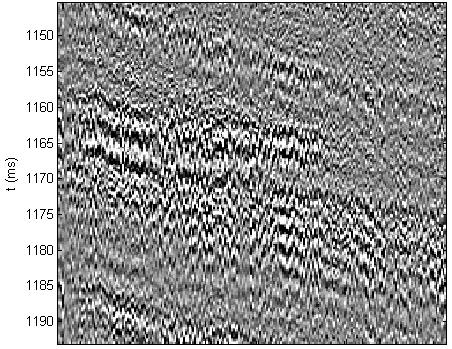
Swell filter
Encyclopedia
The term swell filter in high resolution seismics (reflection seismology
) or sub bottom profiling refers to the static correction that restores the coherence of a high resolution seismic profile. The coherence of the image got lost because of the relative movement (a function of the wavelength of the signal and the swell
) of the source and receiver during the recording. In normal seismic recordings, the term swell filter refers to filtering the acoustic noise, created by waves, out of the seismic recording.
) is applied to make detailed acoustic profiles of a sea floor or lake floor. Acoustic sources used include: air gun, water gun, sleeve gun, sparker and boomer. The frequency used in this field ranges from 100 Hz to 10.000 Hz.
Subbottom profiling is a technique used in acoustical oceanography
. Sonars or echo sounder are typical sources for very high resolution imaging. Also used in this field are parametric echosounders. The main difference with the high resolution seismics is the type of source used.

A detail of a seismic profile recorded during heavy weather.

The same profile swell filtered.
More examples can be found in the seismic image gallery of delph.ixsea.com http://delph.ixsea.com/seismic/gallery/
Reflection seismology
Reflection seismology is a method of exploration geophysics that uses the principles of seismology to estimate the properties of the Earth's subsurface from reflected seismic waves. The method requires a controlled seismic source of energy, such as dynamite/Tovex, a specialized air gun or a...
) or sub bottom profiling refers to the static correction that restores the coherence of a high resolution seismic profile. The coherence of the image got lost because of the relative movement (a function of the wavelength of the signal and the swell
Swell
Swell may refer to:*Swell , a formation of long wavelength ocean surface waves*Swell , an indie rock band from San Francisco*Swell, Gloucestershire, England*Swell , a term in bookbinding...
) of the source and receiver during the recording. In normal seismic recordings, the term swell filter refers to filtering the acoustic noise, created by waves, out of the seismic recording.
High resolution seismics and subbottom profiling
Very high resolution seismics (reflection seismologyReflection seismology
Reflection seismology is a method of exploration geophysics that uses the principles of seismology to estimate the properties of the Earth's subsurface from reflected seismic waves. The method requires a controlled seismic source of energy, such as dynamite/Tovex, a specialized air gun or a...
) is applied to make detailed acoustic profiles of a sea floor or lake floor. Acoustic sources used include: air gun, water gun, sleeve gun, sparker and boomer. The frequency used in this field ranges from 100 Hz to 10.000 Hz.
Subbottom profiling is a technique used in acoustical oceanography
Acoustical oceanography
Acoustical oceanography is the use of underwater sound to study the sea, its boundaries and its contents.-History:The earliest and most widespread use of sound and sonar technology to study the properties of the sea is the use of an echo sounder to measure water depth...
. Sonars or echo sounder are typical sources for very high resolution imaging. Also used in this field are parametric echosounders. The main difference with the high resolution seismics is the type of source used.
Problematic swell
When the movement of the platform and equipment due to swell is too heavy during a seismic recording, the coherence of the image gets lost. The reason why it gets lost is because the movement of source and receiver is larger than the wavelength of the signal produced by the source. As such the seismic reflectors do not line up.
A detail of a seismic profile recorded during heavy weather.

The same profile swell filtered.
More examples can be found in the seismic image gallery of delph.ixsea.com http://delph.ixsea.com/seismic/gallery/
How to build your own swell filter
Building a swell filter is relatively simple: find a good first break detection algorithm (detection of the sea floor) and bandpass the array. Now calculate the static shifts between the original and band passed array and apply them.See also
- DeconvolutionDeconvolutionIn mathematics, deconvolution is an algorithm-based process used to reverse the effects of convolution on recorded data. The concept of deconvolution is widely used in the techniques of signal processing and image processing...
- SEG YSEG YThe SEG Y file format is one of several standards developed by the Society of Exploration Geophysicists for storing geophysical data. It is an open standard, and is controlled by the SEG Technical Standards Committee, a non-profit organization....
- a popular file format for seismic reflection data - Depth conversionDepth conversionDepth conversion is an important step of the seismic reflection method, which converts the acoustic wave travel time to actual depth, based on the acoustic velocity of subsurface medium ....
- the conversion of acoustic waves two-way travel time to actual depth - Seismic waves
- Seismic refractionSeismic refractionSeismic refraction is a geophysical principle governed by Snell's Law. Used in the fields of engineering geology, geotechnical engineering and exploration geophysics, seismic refraction traverses are performed using a seismograph and/or geophone, in an array and an energy source...
- SwellSwellSwell may refer to:*Swell , a formation of long wavelength ocean surface waves*Swell , an indie rock band from San Francisco*Swell, Gloucestershire, England*Swell , a term in bookbinding...

